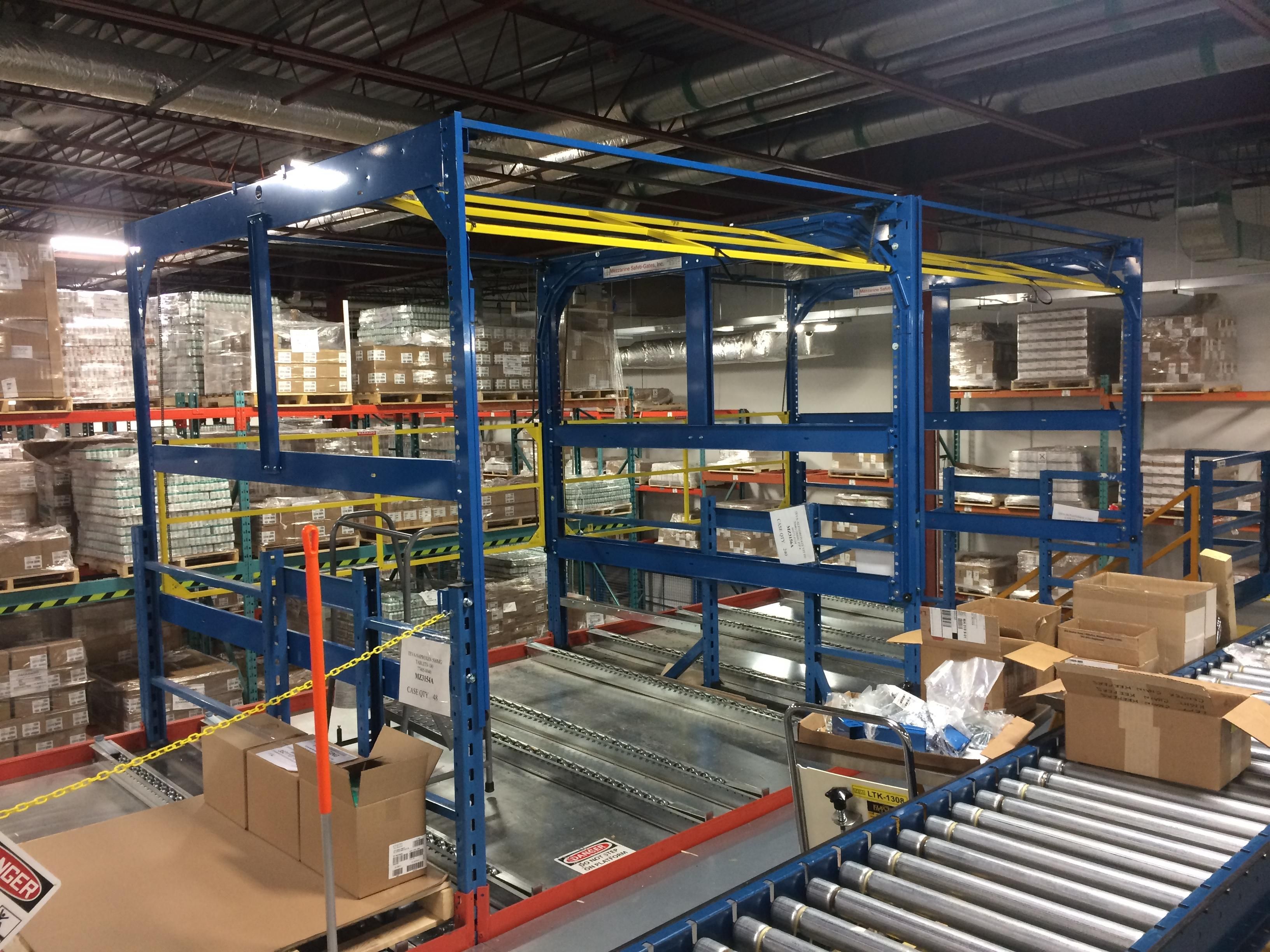
Pallet Flow Lanes: Safety Hazard or Not?
“We decked over those flow lanes, so they don’t need safety gates there.”
That’s a common comment and misconception in industrial facilities where pallet flow lanes are installed in multi-level pick modules. These pallet flow lanes often are safety hazards; the automatic flow of pallets can injure someone standing in the lane, and can expose the worker to falls from the elevated level.
Inherently, the upper levels of pick module create the potential for fall hazards. The pallet flow lanes are installed over the rack system and were traditionally left unguarded because workers were not supposed to enter the lanes, instead they are instructed to pick from the pallet while standing on the platform. Because this positions the worker directly in front of an opening in the floor (and to prevent small items from falling off of the pallet), the lanes are often decked over. This did solve the issue of the loose items falling off the pallet, but it didn’t secure the employees from the opening in the floor, it simply moved this opening to the beginning of the lane.
Again, the thinking was the employee shouldn’t be entering the lane, but instead be standing behind the pallet on the platform. Reality, however, shows a different scenario; employees enter these lanes to retrieve a dislodged item, square up a pallet or simply because they can. This exposes them to being hit by a new pallet entering the lane, as wells as to falling from the upper level.
Because there is an egress on to the lane and a ledge above ground level, the lane should be guarded. In addition, since a pallet can be pushed into someone standing in the ledge, the guarding should be configured that no one can enter the lane while it is being loaded.
We worked in a facility that had a large, multi-level pick module with a number of bays in which they loaded pallets onto two deep pallet flow lanes in double wide bays. Employees were picking from the pallets on the second and third levels of the module. The end user was concerned for fall protection and the general safety of their employees so they were proactively looking for a guarding solution.
In order to permanently secure the ledge while allowing pallets to be loaded a dual-gate system needed to be installed. For this application, we provided a rack-supported version of our Roly safety gate, which uses dual counterbalanced gates that are interconnected so one gate is closed while the other gate is open. The gates were designed double wide to capture the two lanes in the bay and extra deep to capture the entire flow lane. The gate system used support panels that attached directly to the existing rack uprights to maximize space in the bay and for a rigid connection into the system that didn’t need to be lagged down into the decking.
The dual-gate system assured that the rear/operator side gate at the end of the lane was closed while the ledge-side gate was open, allowing the lift truck operator to load the pallets into the lane while a barrier was in place preventing the operator on the platform from entering the lane while the area was being replenished. The gate system was manually operated so the operator would open the ledge side gate when he/she was ready to pick from the pallet, which closed the ledge-side gate, maintaining a safe environment. The system also could be power operated with push-button stations on the lower level, or radio frequency remotes on the lift truck.
The end users on this particular project had concerns that the dual-gate system would impede the pace of their operation, but after installing and using for six months determined that the pace of productivity was not negatively impacted, in fact, it helped to speed up their process. The gate system became a signal between the operator on the platform and the operator on the lift truck. When the picker was ready for the lane to be replenished, he/she would close the operator gate, which opened the ledge-side gate, showing the lift truck operator that that area was ready to receive more pallets. When they were picking from the pallets, the ledge-side gate would be closed, showing the truck operator that those lanes were full or in the process of being picked.
Some companies will try to secure pallet flow lanes with self-closing swinging gates, however, we do not believe this is the right solution. A single gate system such as a swinging gate does not meet current ANSI standards for securing pallet drop areas on elevated platforms because the gates can be left open at times. This same scenario applies to pallet flow lanes, because when the lane is full, the last-pallet-in will hold the gate open, creating an unsafe, unguarded solution. The lane could be extended so the last pallet will travel far enough for the gate to close, but this will lead to production issues because the lift truck operator may load another pallet into a full lane, causing the last pallet to dangerously hang over the ledge and jam up the system. This will create an extremely unsafe area that will create new hazards.
Also, a swinging gate may secure the ledge (if all goes well and it is engineered to fit the system correctly), but it will not solve the secondary issue of keeping an employee out of the lane while the lane is being loaded. We have heard of incidents with pallet being pushed into the legs of operators who were inside the lanes – and these areas were “guarded” by swing gates. A dual-gate system eliminates all of these concerns.